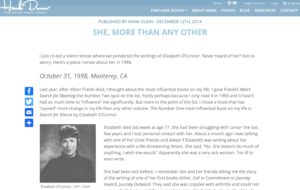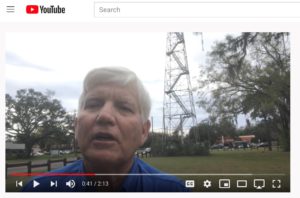The aging Presbyterian minister prayed, “…God, forgive us for our anger when the nurses do not answer the call bell. And for our annoyance when the food is cold. And for…” This went on for a few minutes. OH MY.
I thought it was a good idea. I was preparing to lead the nursing home’s Sunday morning worship service. I asked one of the residents, Horace, to give the morning prayer. He had pastored for well over 50 years and even performed a wedding for a nurses’ aid while he was a resident. Always the pastor.
So, I stood next to his wheelchair and handed him the wireless microphone at the proper time. He started well enough, “Dear Lord,” followed by some nice things to say about the day and the good Lord. Then the more honest prayer kicked in.
This was not what I had planned.
Then again, I had no idea what it was like to be so dependent on others, especially when those others let you down.
Aging forces us to grow spiritually
 Last week, I started exploring “aging as a spiritualizing process.” My plan this week was to unpack an article in theJournal of Religion & Aging on this very topic. I first read that article around the time of the above-mentioned “honest prayer.”
Last week, I started exploring “aging as a spiritualizing process.” My plan this week was to unpack an article in theJournal of Religion & Aging on this very topic. I first read that article around the time of the above-mentioned “honest prayer.”
That piece, “Aging as a Spiritualizing Process,” suggests that aging forces some spiritual practices and virtues on us that we should have learned years before. Here are a few bullets from that article:
- Doing vs. Being: When physical limitations restrict our activities, we finally learn this lesson of the importance of just “being” rather than always “doing.”
- Contingency: Intellectually, we all know we are going to die. As we age and more of our contemporaries die, it starts to sink in that this fact of death is beyond our control. We “take nothing for granted—thankful for even the next breath.”
- Enfleshment: Aches, pain, and disabilities bring home the most basic Hebraic biblical understanding that “We do not have a body, we are a body.”
Not Pollyanna
This is no “Pollyanna approach” to aging and disability — no unflagging optimism, no “let’s see what we can be glad about.” And that’s okay. We can also express the honesty of my friend, the praying pastor, who was having trouble with the tardiness of nurses and cold food. Elisabeth Kübler-Ross did list “anger” and “depression” as aspects of dying.
No one put this more eloquently than Flannery O’Connor, the great writer of Southern fiction, who suffered from lupus for 13 years before she died at age 39 in 1964:
“I have never been anywhere but sick. In a sense, sickness is a place, more instructive than a long trip to Europe, and it’s always a place where there’s no company; where nobody can follow. Sickness before death is a very appropriate thing and I think those who don’t have it miss one of God’s mercies.”

 Rev. Lynn Casteel Harper of the Riverside Church in New York City, sees her role with congregants in their decline as one of “presence and witness.” “Sometimes if people are going through really difficult experiences, especially medically, it’s easy for the story of the illness and the suffering to take over,” Rev. Harper said. “Part of my role is to affirm the other dimensions.”
Rev. Lynn Casteel Harper of the Riverside Church in New York City, sees her role with congregants in their decline as one of “presence and witness.” “Sometimes if people are going through really difficult experiences, especially medically, it’s easy for the story of the illness and the suffering to take over,” Rev. Harper said. “Part of my role is to affirm the other dimensions.” Not so on the HCLP page, where we boosted the post to thousands of strangers. On this page, there were birthday wishes, fireworks, and birthday cakes. Hundreds “Liked” it; dozens even “Loved” it. I can imagine their thinking, “This guy turned 100; surely he deserves recognition.”
Not so on the HCLP page, where we boosted the post to thousands of strangers. On this page, there were birthday wishes, fireworks, and birthday cakes. Hundreds “Liked” it; dozens even “Loved” it. I can imagine their thinking, “This guy turned 100; surely he deserves recognition.” In my post, I mentioned our short attention spans. This fake birthday news only brings this home even more. It was clear people did not take the time to read the post, they just went with the title.
In my post, I mentioned our short attention spans. This fake birthday news only brings this home even more. It was clear people did not take the time to read the post, they just went with the title. In 2002, the National Kidney Foundation published clinical practice guidelines on the evaluation, classification, and stratification of chronic kidney disease (CKD). These guidelines were based on levels found in a patient’s blood chemistry. Patients are classified as “normal/mild,” “moderate,” or “severe.” Those with more severe conditions may be put on dialysis.
In 2002, the National Kidney Foundation published clinical practice guidelines on the evaluation, classification, and stratification of chronic kidney disease (CKD). These guidelines were based on levels found in a patient’s blood chemistry. Patients are classified as “normal/mild,” “moderate,” or “severe.” Those with more severe conditions may be put on dialysis. In 2017,
In 2017, 

